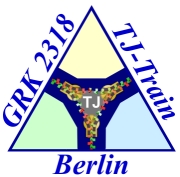
DFG Research Training Group "TJ-Train" (GRK 2318/2) Project A2
Priv.-Doz. Dr.
Jörg Piontek1
1Clinical Physiology / Nutritional Medicine, Campus Benjamin Franklin, Charité - Universitätsmedizin Berlin Structure-based modification of Clostridium perfringens enterotoxin to target claudins Background: Clostridium perfringens enterotoxin (CPE) causes one of the most common food borne illnesses. CPE binds to tight junction (TJ) proteins (e.g. claudin-3 and -4) and subsequently forms pores in the membrane leading to damage of epithelial cells. Due to its cytotoxicity, CPE is used for targeting tumor cells that overexpress specific claudin-subtypes. In contrast, the isolated C-terminal domain of CPE (cCPE) is non-toxic and contains the claudin binding domain. cCPE is used as a TJ modulator to increase paracellular drug delivery. Previously, we elucidated in structure-based studies the molecular mechanism of the CPE-claudin interaction and designed CPE- and cCPE-variants with shifted subtype-specificity to claudins (e.g. binding to claudin-1 or -5 to which CPE-, cCPE-wt does not bind). We started to use these variants to (i) improve paracellular drug delivery in tissue barrier models, (ii) inhibit Hepatitis C Virus infection that depends on claudins and (iii) inhibit growth of thyroid and lung tumors growth. Aim of this project is to expand structure-function studies to design and to test also new variants of cCPE and CPE that target further claudins. These proteins will be used as novel tissue-specific modular biologicals for (i) improved drug delivery by TJ modulation, (ii) molecular diagnosis or (iii) cytotoxic treatment of carcinomas. Methods: Molecular modelling driven site-directed mutagenesis, expression and purification of recombinant proteins, protein-protein interaction assays, cell culture of differentiated epithelial and transformed carcinoma cells, immunocytochemistry and live cell confocal microscopy. Activity of cCPE-and CPE-variants will be tested by measurements of transepithelial resistance and paracellular solute permeability, imaging of cell lines, mouse and human tissue samples as well as cytotoxicity assays with cell lines and in vivo xenotransplant tumor models. 3rd cohort PhD doctoral student
2nd cohort PhD doctoral student
1st cohort PhD doctoral student
04.05.2021: Doctoral examination passed,
"Claudin-Targeting durch Clostridium perfringens Enterotixin-Biologika für die Diagnose und Behandlung von
Tumoren sowie zur Modulation der epidermalen Barriere ", Dr. rer. nat. (PhD), Freie Universität Berlin, magna cum laude Waldow A*, Beier LS*
(*shared first authorship), Arndt J, Schallenberg S, Vollbrecht C, Bischoff P, Farrera-Sal M, Loch FN, Bojarski C, Schumann M, Winkler L, Kamphues C, Ehlen L°, Piontek J°
(°shared last authorship) (2023) cCPE fusion proteins as molecular probes to detect claudins and tight junction dysregulation in gastrointestinal cell lines, tissue explants and patient-derived
organoids. Pharmaceutics 15(7): 1980 (23 pages).
doi: 10.3390/pharmaceutics15071980
(IF 4.9) Beier LS*, Waldow A* (*shared first authorship), Khomeijani Farahani S, Mannweiler R, Vidal-Y-Sy S, Brandner JM, Piontek J°, Günzel D° (°shared last
authorship) (2022) Claudin targeting as an effective tool for directed barrier modulation of the viable epidermis. Ann. NY Acad. Sci.
1517(1): 251-265, doi: 10.1111/nyas.14879 (IF 5.2)
Beier LS, Rossa J, Woodhouse S, Bergmann S, Kramer HB, Protze J, Eichner M, Piontek A, Vidal-y-Sy S, Brandner JM, Krause G, Zitzmann N, Piontek J (2019) Use of modified Clostridium perfringens enterotoxin fragments for claudin targeting in liver and skin
cells. Int. J. Mol. Sci.
20(19): 4774 (20 pages) [PubMed] [WebPage]
[PDF] [Supplement
PDF]
(IF 4.6) Piontek A, Eichner M, Zwanziger D, Beier LS, Protze
J, Walter W, Theurer S, Schmid KW, Führer-Sakel D, Piontek J*, Krause G* (*shared last authorship) (2020) Targeting
claudin-overexpressing thyroid and lung cancer by modified Clostridium perfringens enterotoxin.
Mol. Oncol.
14(2) :261-276
[PubMed] [WebPage] [PDF]
(IF
6.6) Book chapter Beier LS, Piontek J, Piontek A, Protze J, Kobelt D, Walther W (2022) Claudin-targeted suicide gene
therapy for claudin-overexpressing tumor cells by using modified Clostridium perfringens enterotoxin (CPE).
In: Walter W (ed), Gene therapy of cancer.
Methods Mol. Biol. 2521: 173-188.
doi: 10.1007/978-1-0716-2441-8_9 Project-related publications
Piontek A, Eichner M, Zwanziger D, Beier LS, Protze J, Walther W, Theurer S, Schmid KW, Führer-Sakel D, Piontek J, Krause G (2020) Targeting claudin-overexpressing thyroid and lung cancer by modified Clostridium perfringens enterotoxin. Mol Oncol. 14(2):261-276. doi: 10.1002/1878-0261.12615. Beier LS, Rossa J, Woodhouse S, Bergmann S, Kramer HB, Protze J, Eichner M, Piontek A, Vidal-Y-Sy S, Brandner JM, Krause G, Zitzmann N, Piontek J (2019) Use of Modified Clostridium perfringens Enterotoxin Fragments for Claudin Targeting in Liver and Skin Cells. Int J Mol Sci. 20(19). pii: E4774. doi: 10.3390/ijms20194774. Neuhaus W, Piontek A, Protze J, Eichner M, Mahringer A, Subileau EA, Lee IM, Schulzke JD, Krause G, Piontek J. (2018) Reversible opening of the blood-brain barrier by claudin-5-binding variants of Clostridium perfringens enterotoxin's claudin-binding domain. Biomaterials. 161:129-143. doi: 10.1016/j.biomaterials.2018.01.028. Eichner M, Augustin C, Fromm A, Piontek A, Walther W, Bücker R, Fromm M, Krause G, Schulzke JD, Günzel D, Piontek J (2017) In colon epithelia, Clostridium perfringens enterotoxin causes focal leaks by targeting claudins which are apically accessible due to tight junction derangement. J Infect Dis. 217(1):147-157. doi: 10.1093/infdis/jix485. Piontek A, Witte C, May Rose H, Eichner M, Protze J, Krause G, Piontek J, Schröder L (2017) A cCPE-based xenon biosensor for magnetic resonance imaging of claudin-expressing cells. Ann N Y Acad Sci. 1397(1):195-208. doi: 10.1111/nyas.13363. Eichner M, Protze J, Piontek A, Krause G, Piontek J. (2017) Targeting and alteration of tight junctions by bacteria and their virulence factors such as Clostridium perfringens enterotoxin. Pflügers Arch. 469(1):77-90. doi: 10.1007/s00424-016- 1902-x. Review Protze J, Eichner M, Piontek A, Dinter S, Rossa J, Blecharz KG, Vajkoczy P, Piontek J, Krause G (2015) Directed structural modification of Clostridium perfringens enterotoxin to enhance binding to claudin-5. Cell. Mol. Life Sci. 72: 1417- 1432 Veshnyakova A, Piontek J, Protze J, Waziri N, Heise I, Krause G (2012) Mechanism of CPE interaction with claudin-3/-4 protein suggests structural modifications of the toxin to target specific claudin. J. Biol. Chem. 287: 1698-1708 Walther W,
Petkov S, Kuvardina ON, Aumann J, Kobelt D, Fichtner I, Lemm M, Piontek J, Blasig IE, Stein U, Schlag PM (2012)
Novel Clostridium perfringens enterotoxin suicide gene therapy for selective
treatment of claudin-3 and -4 overexpressing tumors. Gene Ther.
19: 494-503
|